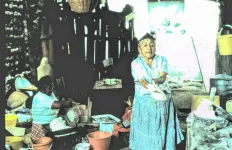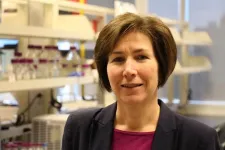(Press-News.org) The move from the ancient system of £sd coinage to 100p to £1 was controversial, considered by some to be a sign of the UK's receding importance on the world stage and even as the beginning of the tumultuous relationship with Europe that ultimately led to Brexit.
But as a result of extensive analysis of a quiet backwater of recent history, Andy argues that the move towards decimalisation had little to do with Europe and in fact was a traditional British compromise.
"It was an event that I remember from my youth, but I found that for such a significant decision that affected everybody in the UK, decimalisation is something that is not covered in much depth," says Andy.
"It was the big news story in my teens. I mean, they changed the money! I wondered if anyone had done much about it, so I read around what people say about this period and what people have said recently about Brexit.
Commonwealth and not Europe a major factor
"Some see it as a harbinger of Europeanisation, leading up to the entry of the UK into the EU and ultimately the reaction to that process resulting in Brexit. My research shows that European considerations played virtually no part in that decision. There is no mention of Europe or the EEC in the original Halsbury Report that paved the way to decimalisation."
On the other hand, the Commonwealth was influential in the move to decimal currency, with South Africa, Australia and New Zealand all committing to decimalisation in the 1960s while Conservative and Labour governments in the UK wavered over whether to move in the same direction.
One option for the British currency was for it to be revalued in alignment with European counterparts like the Franc and the Deutschmark, which were around a tenth of the value of sterling. This was never considered seriously in Britain as it was seen as damaging to British prestige globally.
An exchange between Labour chancellor James Callaghan and BBC's Graham Turner when decimalisation was announced in 1966 underlined the approach:
Callaghan: Speaking for myself I think there's a lot to be said for the pound. Every one of us in Britain is familiar with it, we know what it stands for, abroad they know what it stands for.
Turner: Why have you decided not to use the word 'cent'?
Callaghan: Oh, I much prefer 'penny', why should we go American - penny is a good, it is indeed the oldest coin in Britain, it was originally a silver coin. I see no reason why we should adopt 'cent', it's a miserable sounding word by comparison with penny.
Political and financial wrangles
To understand the development of the new currency, Andy looked at several aspects, "like the way it was managed politically, the lead up to it and how it played up the modernisation agenda - the attempt to arrest a period of British decline".
"I looked at the influence of pressure groups and I found that consumers and retailers, who might have been concerned about currency reform, wanted to follow the lead of Australia and New Zealand in basing the new currency on a unit equal to 10 shillings, or half a pound.
"However, the City and the Bank of England were implacably opposed to any reduction in the value of the major unit, and they decisively influenced the government, playing into the inherent conservative instincts of Harold Wilson's Labour government."
Irish angle still relevant in 2021
The UK's relationship with the Republic of Ireland was another significant element of decimalisation, and is an area of interest for Andy following his MA thesis, which looked at the last days of the Northern Ireland Labour Party in the same era.
He adds that, "Although Ireland eventually decimalised on the same date and on the same basis as the UK, the Irish government delayed their decision for two years, while they gave serious consideration to aligning their currency to that of the main European currencies. This to some extent presaged future developments in relationships between Ireland, the UK and Europe - clearly an issue with huge resonance in the present day.
"I visited the National Archive at Kew, and it was so helpful to be able to access old newspapers from the University, but I also accessed the national archives in Dublin for the Irish angle."
Thesis could be basis for a book
Now retired after working in finance and then teaching in further education, Andy is keen to expand his thesis into a book. COVID-19 put paid to a visit to New Zealand last October where he was due to speak to the Royal New Zealand Numismatic Society, but he was able to present his research at their annual conference via Zoom. Since then a contact from the RNZNS as well as Professor Barry Doyle at Huddersfield have given him ideas for further writing.
Prof Doyle, who supervised Andy's PhD, said, "This is a really original study that explores a topic overlooked by two generations of historians. The thesis was highly commended by the examiners who were particularly impressed with the way it showed the influence of both the Commonwealth and the Republic of Ireland, on the shaping of Britain's currency reform.
"I'm looking forward to seeing Andy's work in book form - it will make a huge contribution to our understanding of the modernisation of the British economy."
INFORMATION:
Biomarkers play a central role in the diagnosis of disease and assessment of its course. Among the markers now in use are genes, proteins, hormones, lipids and other classes of molecules. Biomarkers can be found in the blood, in cerebrospinal fluid, urine and various types of tissues, but most of them have one thing in common: They occur in extremely low concentrations, and are therefore technically challenging to detect and quantify.
Many detection procedures use molecular probes, such as antibodies or short nucleic-acid sequences, which are designed to bind to specific biomarkers. When a probe recognizes and binds to its target, chemical or physical reactions give rise to fluorescence signals. Such methods work well, provided they are sensitive enough to recognize ...
Knowledge on how cells communicate is an important key to understanding many biological systems and diseases. A research team led by researchers at the University of Gothenburg has now used a unique combination of methods to map the mechanism behind cellular communication. Their findings can potentially improve understanding of the underlying mechanism behind type 2 diabetes.
We know that human communication is important, but communication between the cells in our bodies is just as vital. The processes where cells synchronize and coordinate their behaviour is required for an organism to function and for human organs to be able to perform their functions.
"How do cells go from monologues ...
Scientists at the Fralin Biomedical Research Institute at VTC have identified a new zebrafish model that could help advance glioblastoma multiforme research. Glioblastoma is an aggressive form of primary brain tumor - fewer than one in 20 patients survive five years after diagnosis.
The research team previously discovered that human-derived brain cancer cells in mice use the brain's blood vessels like highways to spread away from the original mass. In the new study, published in ACS Pharmacology and Translational Science, they show clear cross-over between mammals and fish and describe similar observations in zebrafish.
"Our hope is that this new work in zebrafish will help researchers ...
COLUMBUS, Ohio - On the outskirts of some small Indigenous communities in the Mexican state of Oaxaca, a few volunteer guards keep watch along roads blocked by makeshift barricades of chains, stones and wood.
The invader they are trying to stop is COVID-19.
For many of Mexico's Indigenous people, poor and ignored by state and federal governments, the fight against the COVID-19 pandemic is one that rests primarily with themselves, said Jeffrey Cohen, a professor of anthropology at The Ohio State University.
That means they must take steps like limiting access to their villages.
"Most of these communities only have ...
peer review/experimental study/animals/cells
Researchers from Uppsala University show in a new study that inhibition of the protein EZH2 can reduce the growth of cancer cells in the blood cancer multiple myeloma. The reduction is caused by changes in the cancer cells' metabolism. These changes can be used as markers to discriminate whether a patient would respond to treatment by EZH2 inhibition. The study has been published in the journal Cell Death & Disease.
Multiple myeloma is a type of blood cancer where immune cells grow in an uncontrolled way in the bone marrow. The disease is very difficult to treat and is still considered incurable, and thus it is urgent to identify new therapeutic targets in the cancer cells.
The research group behind ...
TROY, N.Y. -- An antioxidant found in green tea may increase levels of p53, a natural anti-cancer protein, known as the "guardian of the genome" for its ability to repair DNA damage or destroy cancerous cells. Published today in Nature Communications, a study of the direct interaction between p53 and the green tea compound, epigallocatechin gallate (EGCG), points to a new target for cancer drug discovery.
"Both p53 and EGCG molecules are extremely interesting. Mutations in p53 are found in over 50% of human cancer, while EGCG is the major anti-oxidant in green tea, a popular beverage worldwide," said END ...
DURHAM, N.C. -- Humans aren't the only mammals that form long-term bonds with a single, special mate -- some bats, wolves, beavers, foxes and other animals do, too. But new research suggests the brain circuitry that makes love last in some species may not be the same in others.
The study, appearing Feb. 12 in the journal Scientific Reports, compares monogamous and promiscuous species within a closely related group of lemurs, distant primate cousins of humans from the island Madagascar.
Red-bellied lemurs and mongoose lemurs are among the few species in the lemur family tree in which male-female partners stick together year after year, working together to raise their young and defend their territory.
Once bonded, pairs spend much of their waking hours grooming ...
Every year around 20 Australian children die from the incurable brain tumour, Diffuse Intrinsic Pontine Glioma (DIPG). The average age of diagnosis for DIPG is just seven years. There are no effective treatments, and almost all children die from the disease, usually within one year of diagnosis.
A paper published today 12 Feb 2021 in the prestigious journal, Nature Communications, reveals a potential revolutionary drug combination that - in animal studies and in world first 3D models of the tumour - is "spectacularly effective in eradicating the cancer cells," according to lead researcher and paediatric oncologist Associate Professor David Ziegler, from the Children's Cancer Institute and Sydney Children's Hospital.
In ...
Children treated for cancer with approaches such as chemotherapy can develop therapy-related myeloid neoplasms (a second type of cancer) with a dismal prognosis. Scientists at St. Jude Children's Research Hospital have characterized the genomic abnormalities of 84 such myeloid neoplasms, with potential implications for early interventions to stop the disease. A paper detailing the work was published today in Nature Communications.
The somatic (cancer) and germline (inherited) genomic alterations that drive therapy-related myeloid neoplasms in children have not been comprehensively ...
(Friday, February 12, 2021 - Toronto) -- Inhibiting a key enzyme that controls a large network of proteins important in cell division and growth paves the way for a new class of drugs that could stop glioblastoma, a deadly brain cancer, from growing.
Researchers at Princess Margaret Cancer Centre, the Hospital for Sick Children (SickKids) and University of Toronto, showed that chemically inhibiting the enzyme PRMT5 can suppress the growth of glioblastoma cells.
The inhibition of PRMT5 led to cell senescence, similar to what happens to cells during aging when cells lose the ability to divide and grow. Cellular senescence can also be a powerful tumour suppression mechanism, stopping ...







